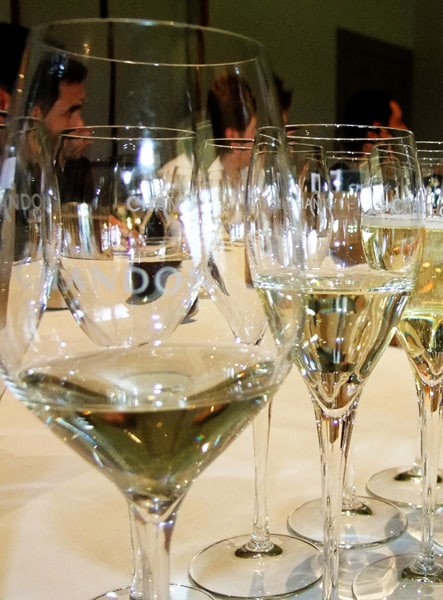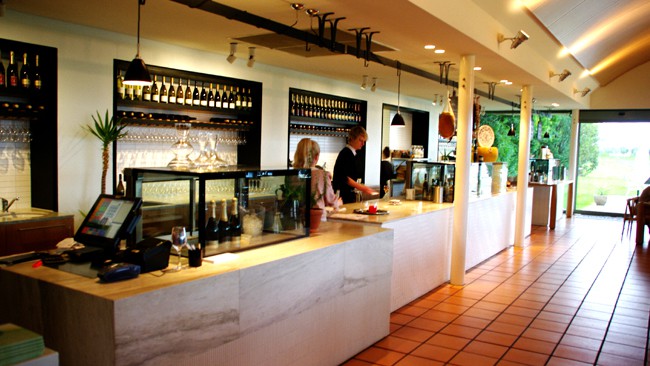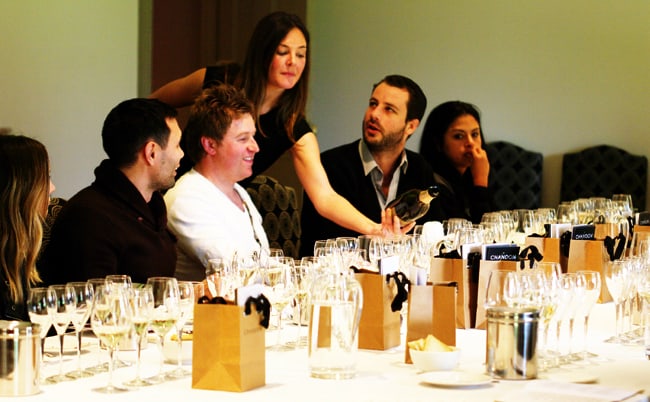Some say it is the nectar of the Gods. Others say that a celebration is not a celebration without it as an accompaniment. Regardless, champagne has a well earned reputation as a special vintage for those memorable occasions.
In Europe and other places around the world, the finest sparklings are sourced from the Champagne region in France, the traditional home of sparkling wine. However, because of Australia’s growing expertise in wine making and its many and varied climates suitable for grape growing, Australia now produces some of the world’s finest sparkling wines and perhaps not surprisingly, one of the world’s oldest and most recognised wine makers, Moet & Chandon have had a considerable role in the establishment of Australia’s sparkling wines.
I recently had the opportunity to visit the home of sparkling wine in Australia. Perhaps somewhat surprisingly, Australia’s most recognised and some say, the home of sparkling wines in this country, can be found within an hour of metropolitan Melbourne.
In the beautiful Victorian Yarra Valley, set high on a ridge overlooking the picturesque valley and towards the mountains that encircle it, is Domaine Chandon, a winery par excellence. This is the home of Australia’s finest bubbly.
To appreciate the winery’s very existence, one must carefully consider the previous history of champagne. The Chandon Australia story actually began in 1743, long before the arrival of the First Fleet in 1788. Chandon Australia’s parent company, the world renowned Moet & Chandon was established in Epernay in France. This famous winery, whose name is synonymous with great champagne, realised in the 1960s that while the company held the largest acreage of vineyards in the region, worldwide demand for champagne was outstripping supply, so, Moet & Chandon decided to give life to the development of wineries outside France, under the Chandon banner.
The company, by that time, had already established Bodegas Chandon in Argentina as well as Chandon in Brazil and the Napa Valley in California. Moet & Chandon also recognised there was an opportunity to produce premium quality sparkling wines in Australia. Accordingly, during the mid-1980s and as a result of the considerable advances made by the Australian wine making industry, the company engaged Australian wine experts to find an ideal site for growing traditional cool climate champagne grape varieties.
After an extensive search, one such ideal site was identified and purchased by Moet & Chandon. The property, situated in the heart of the Yarra Valley, an already established grape growing district, was originally a dairy farm named ‘Green Point. Set high on a ridge in the valley which remained, during the summer months, greener than surrounding properties, the old dairy farm was, from 1986, to become the home of Domaine Chandon in Australia. And so begins a remarkable story of the development of an unique range of Australian sparkling wines produced in the traditional method. The property offered the perfect combination for grape growing – a cool climate and great soil with excellent moisture retention. The 365 acre property has 75 acres of vines and the winery also sources fruit from its other vineyards at Strathbogie as well as other cool climate regions around Victoria and Tasmania. Today, Domaine Chandon is a far cry from the dairy farm of the 1980s although to their credit, the original out-buildings and homestead have been lovingly restored and maintained.
The original homestead, built in the 1880s, of cream sandstone with twin chimney stacks and large open verandahs sits statuesquely at the end of the main driveway at Domaine Chandon – guarded by rows of poplar trees. At the end of a circular driveway, Domaine Chandon have established a star-shaped flower bed which blooms spectacularly in the summer months.
It is here in this beautiful period building that Domaine Chandon conduct ‘Sunday School’ but perhaps not the traditional religious kind although some would say, of the religion of wine making, it has all the right elements of tradition and belief.
The ‘Sunday School’ is a Sunday Wine Experience, par excellence. Conducted by Jane Gordon, a Wine Ambassador for Domaine Chandon, this knowledgeable young lady has probably forgotten more about wines and wine making than most of us will ever know. The ‘Sunday School’ is conducted every Sunday from 11.00 am and involves two and a half hours of expert tuition and wine tasting as well as food pairing. Perhaps this is what makes the Domaine Sunday School so different. There are many wineries around the country which run wine appreciation classes however what sets the Domaine Sunday School experience apart is that, not only does it delve into the making of wines and sparklings, it goes that one step further in matching foods with selected wine styles and vintages. This leaves one well equipped in a broad based knowledge of how to be a great host and consummate entertainer.
For those who are truly passionate about wine, the guided tour gives visitors a ‘behind-the-scenes’ experience of the wine making process, at the home of Australia’s best sparklings. From the barrel cellar to the dark and mystique riddling hall where no less than 72,000 bottles of wine are stored in complete darkness at controlled temperatures and turned regularly, either by hand or by machines.
The winery tour is a must. The tour blends the very best of technology and modern communication methods with the age-old tradition of wine making. Touch screens guide visitors through the various stages of wine making from vineyard to the cellar door. There are some wonderfully historic and age-old traditions associated with wine making such as ‘Plunging the Cap’. In a large room filled with oak barrels known as ‘fat boys’, wine makers plunge the cap, inserting a drawing device which allows them to sample the wines as they mature.
I had always wondered about the difference between French and American oak and why wine makers prefer one from the other. It seems that American oak has stronger vanilla characteristics while French oak, used for Domaine’s best, has a more delicate influence on the vintage.
While annual wine production at Domaine Chandon is always dependent on weather, as is all primary production, last year, the winery pressed 5000 tonnes of grapes, mostly of traditional varietals such as chardonnay, pinot noir and pinot meunier. All the fruit grown at Domaine Chandon is used to produce quality sparkling wines using the ‘methode traditionelle’ or traditional method. Since the first Vintage Brut release in 1986, the winery now produces a range of sparkling wine styles unrivalled in Australia – from the flagship Vintage Brut to a Blanc de Blancs, Brut Rose, Cuvee Riche and the uniquely Australian Sparkling Pinot Shiraz.
From their base of superb sparklings, from the early 1990s, Domaine’s winemakers began producing small quantities of still wines and over the last 20 years, have refined their range of still wines.
In their own right, the Domaine Chandon still wine collection has received widespread acclaim from consumers and wine professionals alike and in addition to its much heralded sparkling range, Domaine Chandon has cemented its position as the Yarra Valley’s leading wine cellar door wine destination. Since 2000 and in recognition of the importance of marrying the right wines with the right foods, Domaine Chandon opened their Brasserie, a popular and perfect place to enjoy the marriage of superb dishes prepared using the best of local produce and the accompanied by a wide selection of distinctive Chandon wines, both stills and sparklings. The Brasserie occupies a stunning position overlooking the sloping vineyards and large water ponds on the property with spectacular views towards the encircling ranges.
Distinct from other cellar door experiences in which wine tastings are only held standing up at a counter or bar, Domaine Chandon was the first winery in Australia to offer wine tastings ‘at the table’, accompanied by a complimentary plate of local produce
It is a pleasant drive on a Sunday morning from down-town Melbourne where I had stayed, to the gates of Domaine Chandon. Just under the hour and you are in the heart of the very beautiful Yarra Valley. I had arrived a little early to take in some of the highlights of the winery although guided tours are conducted three times daily at 11.00am, 1.00pm and 3.00pm. Perhaps not surprisingly, more than one million people have visited the winery since tours commenced in 1991 and the winery continues, to this day, to attract around 200,000 visitors annually.
However, I had come to Domaine Chandon to partake in the ‘Sunday School’. The school is limited to 12 and bookings are essential. Cost is just $75 per person and is worth every cent. It is an incredible adventure which leaves students with a great enlightenment about the art of wine making and more importantly, how to judge and appreciate good wines.
The school features a nine glass collection and sampling of varietals from base wines to the much sought-after 1996 Cuvee, aged 15 years in the cellars at Domaine. The school is held in an impressive dining room in the original homestead with high ceilings, beautiful marble fireplace, polished floor, plastered ceiling and French style doors leading to the large balcony.
There is no more fitting place to spend two and a half hours totally absorbed in one’s subject. We learn that Chandon work with more than 50 growers from different regions, soil types and micro climates to source the best blends of grapes. It is explained that in producing flagship wines, the real focus is on blending and that it is five years before a vine produces good quality grapes.
Australian wines, quite by nature, are also not known as ‘champagnes’. Champagne is only produced in the Champagne Region in France whereas Australia’s sparkling wines have established their own distinctive styles and flavours. I don’t intend to disclose the full Sunday School curriculum, as that would ruin the experience for those wishing to attend a Sunday school with a difference, here are just a few tips learned from the school:
when tastings wines, one should always be able to identify the variety of grape, how old it is and from which region it is drawn.
the first thing to look for is clarity and colour. A good wine should always be clear (expect for unfiltered red wines). If the wine is cloudy, there is probably a fault in production to storage. Colour should range from watery to caramel or golden in colour.
next is the smell. Swirling opens up the wine to oxygen which brings out the aroma. Smelling reveals how the wine is made – the primary characteristic is the presence of fruit; the secondary characteristic is wine maker induced flavours.
taste is the final test. While varieties differ, the general rule is that there should always be an explosion of citrus tastes and crisp acidity in the mouth and one should feel the alcohol at the back of the mouth. Tasting will identify such characteristics as sweetness, tannins and acidity. Aged oak wines will always be heavy in the mouth.
The making of good sparkling, and indeed any good wine, is in the process. After the grapes are harvested – harvesting can either be by hand or by machine at night – they are pressed mechanically by applying pressure equal to that between the thumb and forefinger. The juice is then chilled to four degrees Celsius and the sediment removed.
Yeast is added and alcoholic fermentation begins. The yeast eats all of the sugar in the juice. The carbon dioxide is then removed and what is left from the process is still wine. The juice is then bottled and tranferred to the riddling room and turned carefully in a process designed to remove the yeast.
It was, in fact, Madame Verve de Cliquet who first mastered the art of removing the yeast and topping up the bottles. And of course, the introduction of bubbles softens the acidity. Some things too are important.
Throughout the Sunday School, out host, Jane Gordon, tested our wine knowledge, appreciation of the various varietals offered for tasting as well as tempting our taste buds with some carefully prepared food dishes designed to compliment and enhance the indulgence of the wines.
The schoool finished far too quickly for my liking – much had been learned but there was much still to appreciate so it was down to the tasting room, adjacent to the Brasserie, to try the full range of Domanine Chandon wines. Again, the Brasserie is a highly recommended dining experience but be sure to book either before or on arrival as this superb eatery, with a wonderful reputation for fine food and even better service, fills quickly.
Any visit to Domaine Chandon also requires time to stroll around the picturesque grounds of the winery, to fully appreciate the expansive views and the sheer wonderment of what nature and the science of wine making have created. Any visit to Domaine Chandon is indeed, an unforgettable experience and even more so, if you attend ‘Sunday School’.
Domaine Chandon winery is located in the picturesque Yarra Valley at 727 Maroondah Highway, Coldstream, around an hour or a bit less from Melbourne. For further information, visit –
Story & Photography – Paul Scanlon
Paul is a real globe-trotter who can't get enough of visiting new places and diving into different cultures. He's got a thing for checking out all kinds of landscapes, whether it's a bustling city or a peaceful countryside.
On top of that, Paul's a bit of a knowledge junkie. He loves to learn new stuff and is always on the hunt to know more about the world around him. From facts about the places he visits to the deeper understanding of their cultures, he's always keen to expand his horizons.
With all his travels and his thirst for knowledge, Paul's picked up loads of insights about different parts of the world. His experiences have given him a unique perspective, making him a great person to chat with if you're interested in getting a fresh take on things.




0 Comments